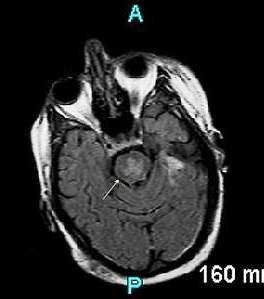- Clinical Technology
- Adult Immunization
- Hepatology
- Pediatric Immunization
- Screening
- Psychiatry
- Allergy
- Women's Health
- Cardiology
- Pediatrics
- Dermatology
- Endocrinology
- Pain Management
- Gastroenterology
- Infectious Disease
- Obesity Medicine
- Rheumatology
- Nephrology
- Neurology
- Pulmonology
A Middle-Aged Alcoholic Woman With Hyponatremia
A 50-year-old woman presented to the emergency department with altered mental status after an unwitnessed fall at home. Her past medical history included bipolar disorder and alcoholism. Medications included fluoxetine, carbamazepine, aripipazole, eszopiclone, and buspirone.
Laboratory findings included severe hyponatremia (sodium, 105 mmol/L [normal, 136-142 mmol/L]) and hypokalemia (potassium, 1.6 mmol/L [normal, 3.5-5.0 mmol/L]). Normal saline with potassium supplementation was administered intravenously at an outside hospital and the patient was transferred to our ICU.
On arrival, the patient became hypotensive and was successfully resuscitated with 1 L of 0.9% saline solution. After resuscitation, her Glasgow Coma Scale (GCS) score was 8 (range, 3-15, where 8 = coma), without focal neurological deficit. She had contusions over the face, scalp, and neck.
Six hours after the initial fluid resuscitation, lab tests showed a sodium level of 113 mmol/L and potassium of 2.4 mmol/L. Blood levels of carbamazepine were therapeutic, and there was no trace of alcohol. Urine toxicology results were normal.
The patient’s regular medications were discontinued. She was treated for hyponatremia with intravenous 3% saline at 10 mL/h for several hours, then switched to 0.9% saline with potassium supplementation at 80 mL/h. Serum electrolyte levels measured every 4 hours showed rising sodium levels from 113 to 115, 115, 117, and 120 mmol/L.
Given the overly rapid rise in serum sodium (15 mmol/L over the first 21 hours), 0.9% saline fluid was stopped. The patient’s mental status slowly improved (a subsequent GCS score of 15 points) and her serum sodium level normalized over the next 5 to 6 days.

On hospital day 10, the patient experienced changes in mental status, decreasing verbal output, dysphagia, behavior changes, and spastic quadriparesis. A T2-weighted MRI of the brain revealed a hyperintense signal in the central pons, consistent with central pontine myelinolysis. There was also an increased signal along the left tentorium representing a small subdural hematoma (Figure).
Supportive treatment was provided with percutaneous endoscopic gastrostomy tube feeding, a prophylactic tracheostomy, and speech and physical therapy. With supportive treatment, there was gradual improvement before the patient was discharged to a rehabilitation center.
Discussion
Osmotic demyelination syndrome (ODS) involves central pontine and/or extrapontine myelinolysis and primarily occurs following overly rapid correction of severe hyponatremia that has been present for a few days. This is the time period required for the cerebral adaptation to occur.1-3
The major risk factors for onset of ODS are:
• A serum sodium concentration of 120 mEq/L or less at presentation.
• The duration of severe hyponatremia.
• The rate at which hyponatremia is corrected.
Alcoholism, malnutrition, liver disease, and hypokalemia appear to increase the susceptibility to osmotic demyelination. In patients with these disorders, ODS symptoms can develop when hyponatremia is less severe (serum sodium concentration >120 mEq/L) and at rates of serum sodium correction that might not be otherwise judged as overly rapid.2
The onset of ODS is typically delayed for up to 6 days after a precipitous elevation of serum sodium concentration.2 The clinical presentation evolves rapidly and includes dysarthria, dysphagia, paraparesis or quadriparesis, behavioral disturbances, lethargy, confusion, disorientation, obtundation, and coma. A severely affected patient may experience “locked-in” syndrome.
Imaging results obtained during the first week after injury can be normal. Thus, an initially negative radiologic study in a patient with the classic ODS neurologic symptoms after overly rapid correction of hyponatremia does not exclude ODS.4 The typical finding on MRI study-of central pontine myelinolysis-is a hyperintense lesion in T2-weighted images of the central pons, with sparing of the corticospinal tract and the periphery of the pons that results in a characteristic “batwing” or trident configuration.
ODS is associated with a poor prognosis and prevention is of primary importance. Goals for correction of severe hyponatremia of 2 or more day’s duration are based on daily, rather than hourly, rates of correction. The rate of serum sodium correction should be less than 10 mEq/L in the first 24 hours and less than 18 mEq/L in the first 48 hours to prevent ODS.
There is no proven treatment for ODS. Aggressive supportive therapy, which is the mainstay, should be provided to all patients who were functional before the onset of symptoms. Aspiration pneumonia and respiratory failure can develop in severe ODS; those affected need ventilatory support.
Recovery from seemingly hopeless neurologic deficits is possible.5 Supportive therapy, therefore, should be continued for at least 6 to 8 weeks before sequelae are deemed irreversible.5
Teaching Points
• ODS is associated with a poor prognosis, thus, prevention is of primary importance.
• The rate of serum sodium correction should be less than 10 mEq/L in the first 24 hours and less than 18 mEq/L in the first 48 hours to prevent ODS.
• In select groups of patients, especially alcoholics, where the susceptibility to osmotic demyelination is increased, the rate of serum sodium correction should be cautiously monitored.
References:
References
1. Verbalis JG, Goldsmith SR, Greenberg A, et al. Hyponatremia treatment guidelines 2007: expert panel recommendations. Am J Med. 2007;120(suppl 1):S1.
2. Sterns RH, Cappuccio JD, Silver SM, Cohen EP. Neurologic sequelae after treatment of severe hyponatremia: a multicenter perspective. J Am Soc Nephrol. 1994;4:1522-1530.
3. Sterns RH, Hix JK, Silver S. Treatment of hyponatremia. Curr Opin Nephrol Hypertens. 2010;19:493-498.
4. Karp BI, Laureno R. Pontine and extrapontine myelinolysis: a neurologic disorder following rapid correction of hyponatremia. Medicine (Baltimore). 1993;72:359-373.
5. Menger H, Jörg J. Outcome of central pontine and extrapontine myelinolysis. J Neurol. 1999;246:700-705.
